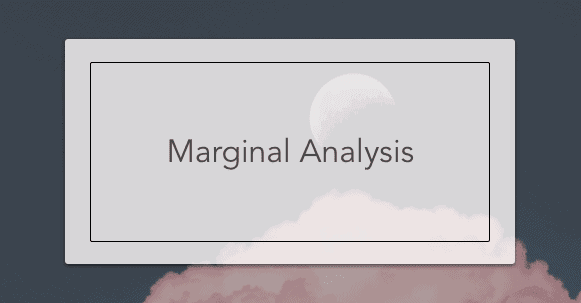In the field of economics, marginal analysis entails the examination of the final or next unit of cost or of consumption. It involves a cost-benefit analysis of business decisions—that is, understanding whether a particular decision provides enough benefits to be worth the cost of that decision.
To give a straightforward marginal analysis definition, it is a cost-benefit comparison between a given activity’s additional costs and its additional benefits. “Marginal” means that the cost-benefit being analyzed is that of the next unit or individual, such as the added cost and added benefit of hiring one more worker.
How is Marginal Analysis Used?
As with most economic concepts, when decision-makers use marginal analysis as a tool, their ultimate goal is typically to ensure maximized profits. Marginal analysis is an enormously useful management strategy.
Firms and manufacturers use marginal analysis to understand the cost and benefits of growing their businesses, e.g. with increased levels of production or by expanding to offer a broader range of goods and services. Before making such a decision, it is important to ensure that the benefit will outweigh the cost and will thereby contribute to greater profits, rather than resulting in financial drain. Businesses can likewise decide between two possible investment opportunities, figuring out which will provide greater benefits than their associated costs.
Economists apply marginal analysis in the sub-field of microeconomics. It can allow them to understand the way in which complex systems are influenced as a result of marginally altering their variables. This can answer the important question of how seemingly minor decisions and shifts create significant, notable ripple effects within businesses and markets.
Marginal Analysis Example
Here’s one example that’s pretty easy to understand. Consider that it costs a great deal of money to fly a plane across the United States—for instance, from New York to California. When roughly 90 percent of the seats are full, though, the cost of carrying another passenger is negligible, and will also provide hundreds of dollars more to the airline company when the passenger purchases their ticket.
Therefore, because the marginal cost of carrying one more passenger is quite low when the plane is 90 percent full, it is a smart financial decision to sell a ticket to another passenger. Making sure that the plane is full will maximize the profits and most effectively outweigh the high cost of flying the plane from one coast to the other.
Marginal Benefit Compared to Marginal Cost
Marginal benefit is the amount of increase in the benefit provided to the consumer by using one more unit of a good/service. Meanwhile, marginal cost is the amount of increase in the cost paid by a firm to produce one more unit of a good/service.
Marginal benefits tend to decrease with increasing consumption by a consumer. For instance, if someone buys a sandwich, the marginal benefit of buying a second sandwich will be greater than the marginal benefit of then buying a third sandwich, because the consumer will become less hungry over time and will have less need for food. And in the case of economies of scale, marginal costs typically decrease as firms produce higher quantities of a particular good. At high quantities, companies can produce a good at a lower cost per unit. This increases their profits.

